NWA 5492
ChondriteChondrites are the most common meteorites accounting for ~84% of falls. Chondrites are comprised mostly of Fe- and Mg-bearing silicate minerals (found in both chondrules and fine grained matrix), reduced Fe/Ni metal (found in various states like large blebs, small grains and/or even chondrule rims), and various refractory inclusions (such Click on Term to Read More, ungroupedModifying term used to describe meteorites that are mineralogically and/or chemically unique and defy classification into the group or sub-group they most closely resemble. Some examples include Ungrouped Achondrite (achondrite-ung), Ungrouped Chondrite (chondrite-ung), Ungrouped Iron (iron-ung), and Ungrouped Carbonaceous (C-ung). Click on Term to Read More
(type 3, highly-reduced, metal-rich brecciaWork in Progress ... A rock that is a mechanical mixture of different minerals and/or rock fragments (clasts). A breccia may also be distinguished by the origin of its clasts: (monomict breccia: monogenetic or monolithologic, and polymict breccia: polygenetic or polylithologic). The proportions of these fragments within the unbrecciated material Click on Term to Read More)
‘G chondrite’ 
click on the image for a magnified view Found 2008
no coordinates reported A single moderately weathered stone weighing 587 g was found in Algeria and sold in Tucson in January 2009 to M. Farmer and J. Strope. After the stone was cut into thin slices on a wire-saw (A. Karl), leaving ~450 g after accounting for the cutting loss, samples were sent to several investigators (T. Bunch and J. Wittke, NAU; M. Weisberg, KCCU) for study and classification. A preliminary classification was given for NWA 5492 as an anomalous member of the CB chondriteClass also known as bencubbinites, are named after the Bencubbin meteorite found in 1930 in Australia. Only a handful of these strange meteorites are known, all composed of >50 vol. % Ni-Fe metal, together with highly reduced silicates, and chondrules similar to those found in the CR group. Click on Term to Read More group.
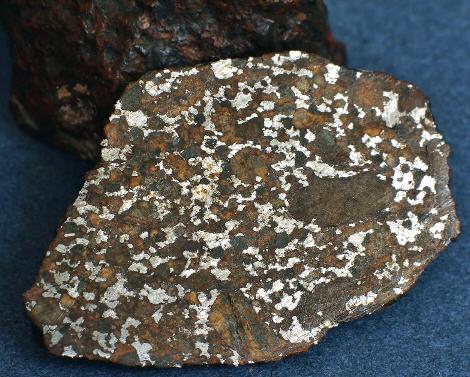
Photo courtesy of Timur Kryachko It has been posited that after Jupiter had grown to a massive size (>50 M⊕) by ~4 m.y. at an initial heliocentricCentered around a sun. Our own Solar System is centered around the Sun so that all planets such as Earth orbit around the Sun. Note that 25% of Americans incorrectly believe the Sun revolves around the Earth. Click on Term to Read More distance of ~3 AUThe astronomical unit for length is described as the "mean" distance (average of aphelion and perihelion distances) between the Earth and the Sun. Though most references state the value for 1 AU to be approximately 150 million kilometers, the currently accepted precise value for the AU is 149,597,870.66 km. The Click on Term to Read More, it underwent a chaotic migration in a 3:2 (or 2:1) resonance with Saturn—first inward for ~100,000 years to ~1.5–2.0 AU while clearing the inner disk of planetesimalsHypothetical solid celestial body that accumulated during the last stages of accretion. These bodies, from ~1-100 km in size, formed in the early solar system by accretion of dust (rock) and ice (if present) in the central plane of the solar nebula. Most planetesimals accreted to planets, but many – Click on Term to Read More, an then outward for ~4–5 m.y. years to its current location near 5.2 AU (‘Grand Tack’ scenario of Walsh et al., 2011; Johnson et al., 2016; Brasser et al., 2016). Planetary modeling employed by Johnson et al. (2016) demonstrates that only during a relatively short timeframe within this migration period will dynamical excitement produce impact velocities that reach levels high enough (>18 [±5] km/s) to vaporize Fe in a planetesimal coreIn the context of planetary formation, the core is the central region of a large differentiated asteroid, planet or moon and made up of denser materials than the surrounding mantle and crust. For example, the cores of the Earth, the terrestrial planets and differentiated asteroids are rich in metallic iron-nickel. Click on Term to Read More. Their model is consistent with the late timing of the vapor plume from which the CB chondrites condensed, and in a similar manner the NWA 5492, GRO 95551, and Sierra Gorda 009 chondrites may derive through condensation from an impact-generated vapor plume; however, chondrule ages for these three meteorites have not yet been established. Further details about the ‘Grand Tack’ scenario can be found in the Appendix Part III. Weisberg et al. (2011, 2012) determined that silicates in NWA 5492 are much more highly reducedOxidation and reduction together are called redox (reduction and oxidation) and generally characterized by the transfer of electrons between chemical species, like molecules, atoms or ions, where one species undergoes oxidation, a loss of electrons, while another species undergoes reduction, a gain of electrons. This transfer of electrons between reactants Click on Term to Read More than those in E, CH, and CB chondrites, and are primarily composed of nearly pure enstatiteA mineral that is composed of Mg-rich pyroxene, MgSiO3. It is the magnesium endmember of the pyroxene silicate mineral series - enstatite (MgSiO3) to ferrosilite (FeSiO3). Click on Term to Read More (Fs0.3–1.6). The components present in NWA 5492 include (vol%) orthopyroxeneOrthorhombic, low-Ca pyroxene common in chondrites. Its compositional range runs from all Mg-rich enstatite, MgSiO3 to Fe-rich ferrosilite, FeSiO3. These end-members form an almost complete solid solution where Mg2+ substitutes for Fe2+ up to about 90 mol. % and Ca substitutes no more than ~5 mol. % (higher Ca2+ contents occur Click on Term to Read More (39.9), FeNi-metal (21.6 [primarily low-Ni]), plagioclaseAlso referred to as the plagioclase feldspar series. Plagioclase is a common rock-forming series of feldspar minerals containing a continuous solid solution of calcium and sodium: (Na1-x,Cax)(Alx+1,Si1-x)Si2O8 where x = 0 to 1. The Ca-rich end-member is called anorthite (pure anorthite has formula: CaAl2Si2O8) and the Na-rich end-member is albite Click on Term to Read More feldsparAn alumino-silicate mineral containing a solid solution of calcium, sodium and potassium. Over half the Earth’s crust is composed of feldspars and due to their abundance, feldspars are used in the classification of igneous rocks. A more complete explanation can be found on the feldspar group page. Click on Term to Read More (13.3), forsteritic olivineGroup of silicate minerals, (Mg,Fe)2SiO4, with the compositional endpoints of forsterite (Mg2SiO4) and fayalite (Fe2SiO4). Olivine is commonly found in all chondrites within both the matrix and chondrules, achondrites including most primitive achondrites and some evolved achondrites, in pallasites as large yellow-green crystals (brown when terrestrialized), in the silicate portion Click on Term to Read More (5.6 [Fa0.1–0.7]), clinopyroxene (3.7), silicaSilicon dioxide, SiO2. (2.7), sulfides (2.2), and schreibersiteNi-Fe phosphide mineral, (Fe,Ni)3P, yellowish in color and predominantly found in iron and stony-iron meteorites. Schreibersite can also be found in a variety of other meteorites including some acapulcoites, aubrites, enstatite chondrites and achondrites, lunars, ureilites, winonaites and a smattering of other meteorite types like CM, CO and CB. Schreibersite Click on Term to Read More (1.6), with the remainder constituting unidentified materials. Some chondrule silicates in NWA 5492 and GRO 95551 contain sub-µm- to µm-sized metalElement that readily forms cations and has metallic bonds; sometimes said to be similar to a cation in a cloud of electrons. The metals are one of the three groups of elements as distinguished by their ionization and bonding properties, along with the metalloids and nonmetals. A diagonal line drawn Click on Term to Read More blebs, which also attest to highly reducingOxidation and reduction together are called redox (reduction and oxidation) and generally characterized by the transfer of electrons between chemical species, like molecules, atoms or ions, where one species undergoes oxidation, a loss of electrons, while another species undergoes reduction, a gain of electrons. This transfer of electrons between reactants Click on Term to Read More conditions during formation (Weiberg et al., 2015). The olivine abundance in NWA 5492 is similar to that of E chondrites (5.9 vol%), but the olivine in NWA 5492 is more highly magnesian (Fa0.1–0.7) compared to E chondrites or any other metal-rich chondrite group; olivine in GRO 9551 is similarly highly magnesian (ave. Fa1.3). In comparison to E chondrites and all other chondrite groups, significant differences in elemental ratios and elemental abundances are observed (see diagram). Moreover, the metal in NWA 5492 and GRO 9551 is unlike that in E, CH, and CB chondrites in that it contains very low Si; in that respect it is more similar to H-chondrite metal (Humayun and Weisberg, 2012; Weiberg et al., 2015). Notably, this unique breccia contains no CAIsSub-millimeter to centimeter-sized amorphous objects found typically in carbonaceous chondrites and ranging in color from white to greyish white and even light pink. CAIs have occasionally been found in ordinary chondrites, such as the L3.00 chondrite, NWA 8276 (Sara Russell, 2016). CAIs are also known as refractory inclusions since they Click on Term to Read More or AOAs (although rare Al-rich chondrules have been reported by Weisberg et al., 2015), and it contains both a higher abundance of sulfides and a higher Na content in the plagioclase-rich mesostasisLast material to crystallize/solidify from a melt. Mesostasis can be found in both chondrules, in the matrix around chondrules, and in achondrites as interstitial fine-grained material such as plagioclase, and/or as glass between crystalline minerals. Click on Term to Read More than is found in CH or CB chondrites. By comparison, the high abundance and variability of sulfides present in E chondrites is not observed in NWA 5492. An O-isotopic composition was determined for NWA 5492 (D. Rumble III, CIW), and its position on a three-isotope plot is unique among chondritic meteorites; sample clasts plot within two distinct reservoirs. The main plot (a), based on a sample of smaller-sized reduced chondrules and fragments that likely represent the parent bodyThe body from which a meteorite or meteoroid was derived prior to its ejection. Some parent bodies were destroyed early in the formation of our Solar System, while others like the asteroid 4-Vesta and Mars are still observable today. Click on Term to Read More, lies in an unoccupied region above the TFL just below the OC field and just above the EC field (Δ17O = 0.43; NWA 5492a/CR,CH plot). The other less prevalent O-isotopic plot (b), which is the result of analyzing certain barred chondrule clasts, lies along the CR trend line (Δ17O = -2.28; NWA 5492b/CR,CH plot). This plot (b) might represent impacts of diverse objects possibly related to the CR Clan onto the NWA 5492 parent body. Notably, plot (a) lies near to, or overlaps that determined for chondrules in GRO 95551, which supports the formation of both meteorites in a similar oxygenElement that makes up 20.95 vol. % of the Earth's atmosphere at ground level, 89 wt. % of seawater and 46.6 wt. % (94 vol. %) of Earth's crust. It appears to be the third most abundant element in the universe (after H and He), but has an abundance only Click on Term to Read More reservoir (see diagram below). Further O-isotopic analyses of NWA 5492 and GRO 95111 conducted by Weisberg et al. (2015) demonstrates that some overlap exists with O and E chondrites.

Diagram credit: Weisberg et al., 42nd LPSC, #1198 (2011) In their study of the fossil meteoriteThe textural, mineralogical or compositional remnant within a sedimentary rock of a meteorite that fell millions of years ago and found in Ordovician limestone from Sweden. Read Tiny Traces of a Big Asteroid Breakup for a complete writeup on this subject. In picture to the left a nautiloid shell is Click on Term to Read More Österplana 065, Schmitz et al. (2016) included oxygen and chromium isotopic data obtained by Sanborn et al. (2015, abstract) for NWA 5492 and its likely genetic relative GRO 95551 in a coupled Δ17O vs. ε54Cr diagram (shown below). It shows that these two metal-rich meteorites plot in a distinct location in isotopeOne of two or more atoms with the same atomic number (Z), but different mass (A). For example, hydrogen has three isotopes: 1H, 2H (deuterium), and 3H (tritium). Different isotopes of a given element have different numbers of neutrons in the nucleus. Click on Term to Read More space, indicating that they derive from a unique parent body. Chromium vs. Oxygen Isotope Plot
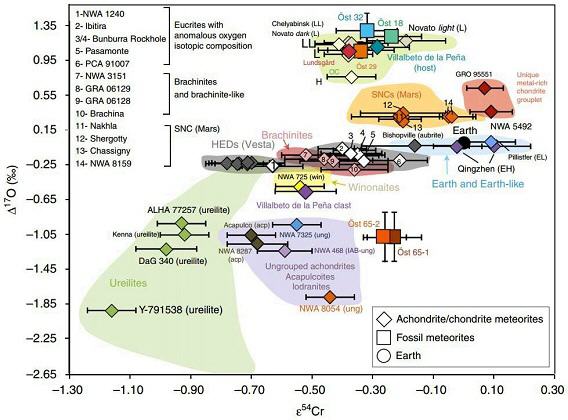
click on image for a magnified view Diagram credit: Schmitz, B. et al., Nature Communications, vol. 7, p. 4 (2016, open access link)
‘A new type of solar-system material recovered from Ordovician marine limestoneA common form of calcium carbonate (CaCO3). Other common forms of CaCO3 include chalk and marble. Click on Term to Read More ‘
(https://doi.org/10.1038/ncomms11851)’ Weisberg et al. (2015) demonstrated that an overlap exists in O-isotope values between chondrules from NWA 5492 and GRO 95551 and those from O, E, and R chondrites, which is indicative of a close relationship among them. They suggest that the chondrules (or their precursor material) which constitute these disparate meteorites likely formed in a similar nebulaAn immense interstellar, diffuse cloud of gas and dust from which a central star and surrounding planets and planetesimals condense and accrete. The properties of nebulae vary enormously and depend on their composition as well as the environment in which they are situated. Emission nebula are powered by young, massive Click on Term to Read More environment and/or experienced similar petrogenetic processes, and mixing of material between these nebula reservoirs may have occurred. Warren (2011) determined that the isotope signatures of ε54Cr, ε50Ti, and ε62Ni can be utilized to resolve carbonaceous from non-carbonaceous meteorites; the carbonaceous meteorites have positive values for all of these elements, while the non-carbonaceous meteorites have negative values. An example coupled Δ17O vs. 54Cr diagram is shown below to demonstrate the separation between carbonaceous and non-carbonaceous meteorites. It can be seen that the chondrite GRO 5551, and by inference NWA 5492, both plot in the non-carbonaceous field.

Diagram credit: P. Warren, GCA, vol. 75, p. 6916 (2011)
‘Stable isotopes and the noncarbonaceous derivation of ureilites, in common with nearly all differentiated planetary materials’
(http://dx.doi.org/10.1016/j.gca.2011.09.011) The Hf–W age determined for NWA 5492 is very old, falling within 0.7 m.y. of CAISub-millimeter to centimeter-sized amorphous objects found typically in carbonaceous chondrites and ranging in color from white to greyish white and even light pink. CAIs have occasionally been found in ordinary chondrites, such as the L3.00 chondrite, NWA 8276 (Sara Russell, 2016). CAIs are also known as refractory inclusions since they Click on Term to Read More formation, which possibly dates the stage of nebular metal–silicateThe most abundant group of minerals in Earth's crust, the structure of silicates are dominated by the silica tetrahedron, SiO44-, with metal ions occurring between tetrahedra). The mesodesmic bonds of the silicon tetrahedron allow extensive polymerization and silicates are classified according to the amount of linking that occurs between the condensation (Friend et al., 2011). It is proposed that NWA 5492 represents a new chondrite type having close affinities (e.g., chemical, textural, isotopic, metal composition) to GRO 95551. Both meteorites share elemental abundance ratios that may have some relationship to E and H chondrites, but which plot away from known chondrite groups. Evidence favors a nebular condensateIn the solar nebula, product of a chemical condensation reaction where a mineral phase precipitates (condenses) directly from a cooling vapor. Click on Term to Read More origin (vs. impact origin) for the majority of the components in NWA 5492 (Weisberg et al., 2011); it is composed of the same type of volatile-depleted, reduced material that is believed to have accreted to form the primitive Earth (Friend et al., 2011). By comparison to the highly-reduced, low-FeO, metal-rich group of chondrites, and to the highly-reduced, metal-rich, chondrites designated ‘HH chondrites’, the latter considered by some to be the parental source of IIE irons (e.g., J. T. Wason, 2017), the silicates in NWA 5492 and GRO 95551 are much more reduced and have a lower Ni content in metal. Such extensive reductionOxidation and reduction together are called redox (reduction and oxidation) and generally characterized by the transfer of electrons between chemical species, like molecules, atoms or ions, where one species undergoes oxidation, a loss of electrons, while another species undergoes reduction, a gain of electrons. This transfer of electrons between reactants Click on Term to Read More features preclude them from being the precursor material of either of these groups (Humayun and Weisberg, 2012; Weisberg et al., 2015). A range of shock levels (S1 to S3–5) for NWA 5492 has been reported by different investigators utilizing different samples; the observation of S1 might be attributable to post-shock annealing (Weisberg et al., 2015); features in GRO 95551 are consistent with shock stageA petrographic assessment, using features observed in minerals grains, of the degree to which a meteorite has undergone shock metamorphism. The highest stage observed in 25% of the indicator grains is used to determine the stage. Also called "shock level". Click on Term to Read More S3. The CRE age of NWA 5492 is ~8 m.y. (3He, 21Ne, and 38Ar; Friend et al., 2011). It has been demonstrated that a plot of two meteorites on a coupled Δ17O vs. ε54Cr diagram is one of the best diagnostic tools for determining possible genetic relationships between them (Sanborn et al., 2014). High-precision Cr-isotopic analysis (ε53Cr and ε54Cr) of both NWA 5492 and GRO 95551 were conducted by Sanborn et al. (2015). The results show that NWA 5492 and GRO 95551 are indistinguishable in their Cr-isotopic compositions, consistent with their similarity in O-isotopic compositions previously determined. Furthermore, although the ε54Cr values show that these two meteorites are not associated with any of the carbonaceous chondriteCarbonaceous chondrites represent the most primitive rock samples of our solar system. This rare (less than 5% of all meteorite falls) class of meteorites are a time capsule from the earliest days in the formation of our solar system. They are divided into the following compositional groups that, other than Click on Term to Read More groups, only through the combined Δ17O vs. ε54Cr plot is it evident that NWA 5492 and GRO 95551 are also not genetically related to the E chondrite groups. Data obtained thus far (e.g., petrologic, isotopic, silicate and metal composition) indicate that NWA 5492 and GRO 95551 derive from a similar unique isotopic reservoir, but further research as well as new recoveries could show that they share a common parent body. It was recommended by Weisberg et al. (2015) that these two meteorites be termed ‘G chondrites’ after the first described type specimen GRO 95551. The specimen of NWA 5492 shown above is a 2.15 g thin partial slice, ~1 mm in thickness. The small vesicles which are visible in the magnified image are attributed to degassing of hydrated clasts during impacts onto the parent body (Perron et al., 2008). The photos below show the high free metal component in this meteoriteWork in progress. A solid natural object reaching a planet’s surface from interplanetary space. Solid portion of a meteoroid that survives its fall to Earth, or some other body. Meteorites are classified as stony meteorites, iron meteorites, and stony-iron meteorites. These groups are further divided according to their mineralogy and Click on Term to Read More specimen and in a full slice curated by the Chicago Field Museum, as well as a close-up image from Michael Farmer.
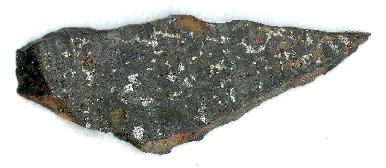
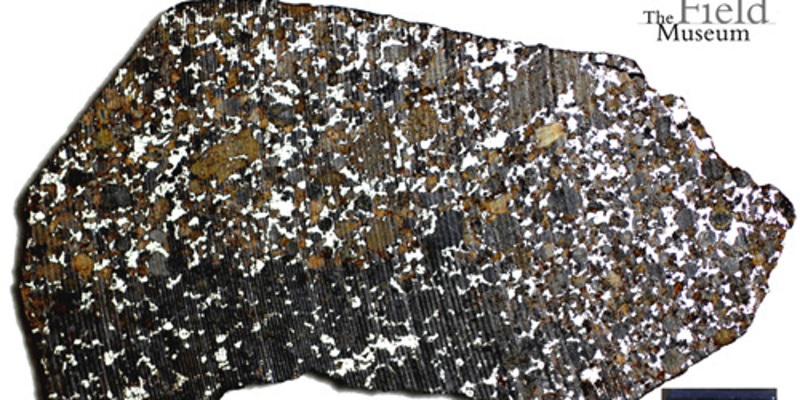
Photo source: Chicago Field Museum
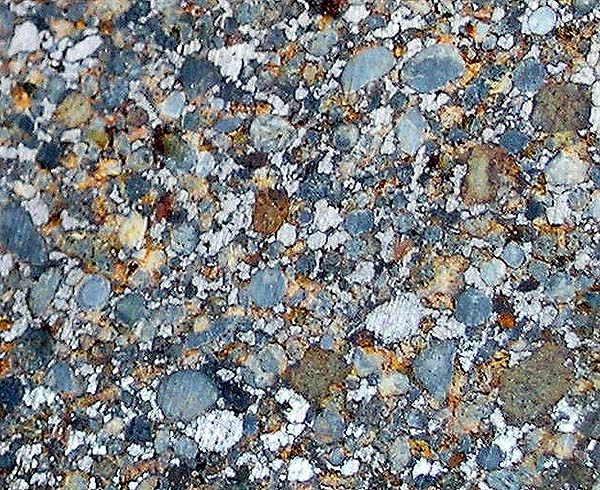
Close-up photo courtesy of Michael Farmer—Michael Farmer Meteorites






